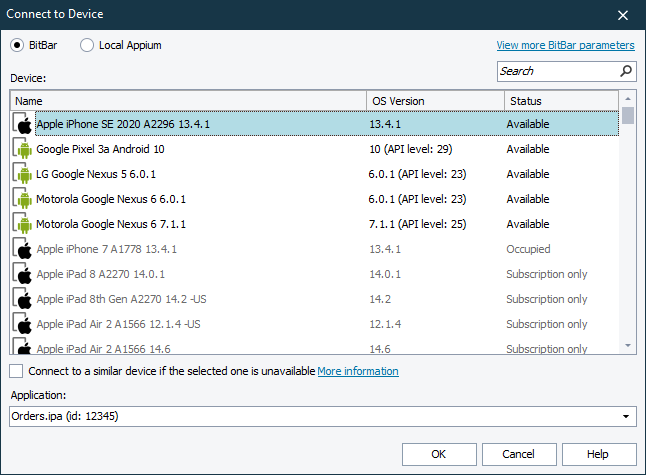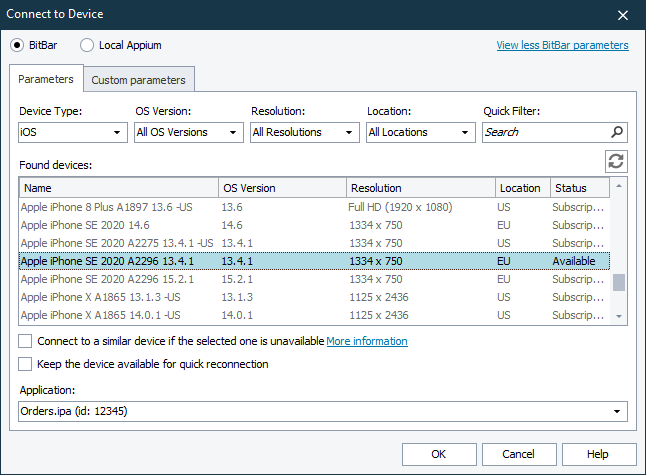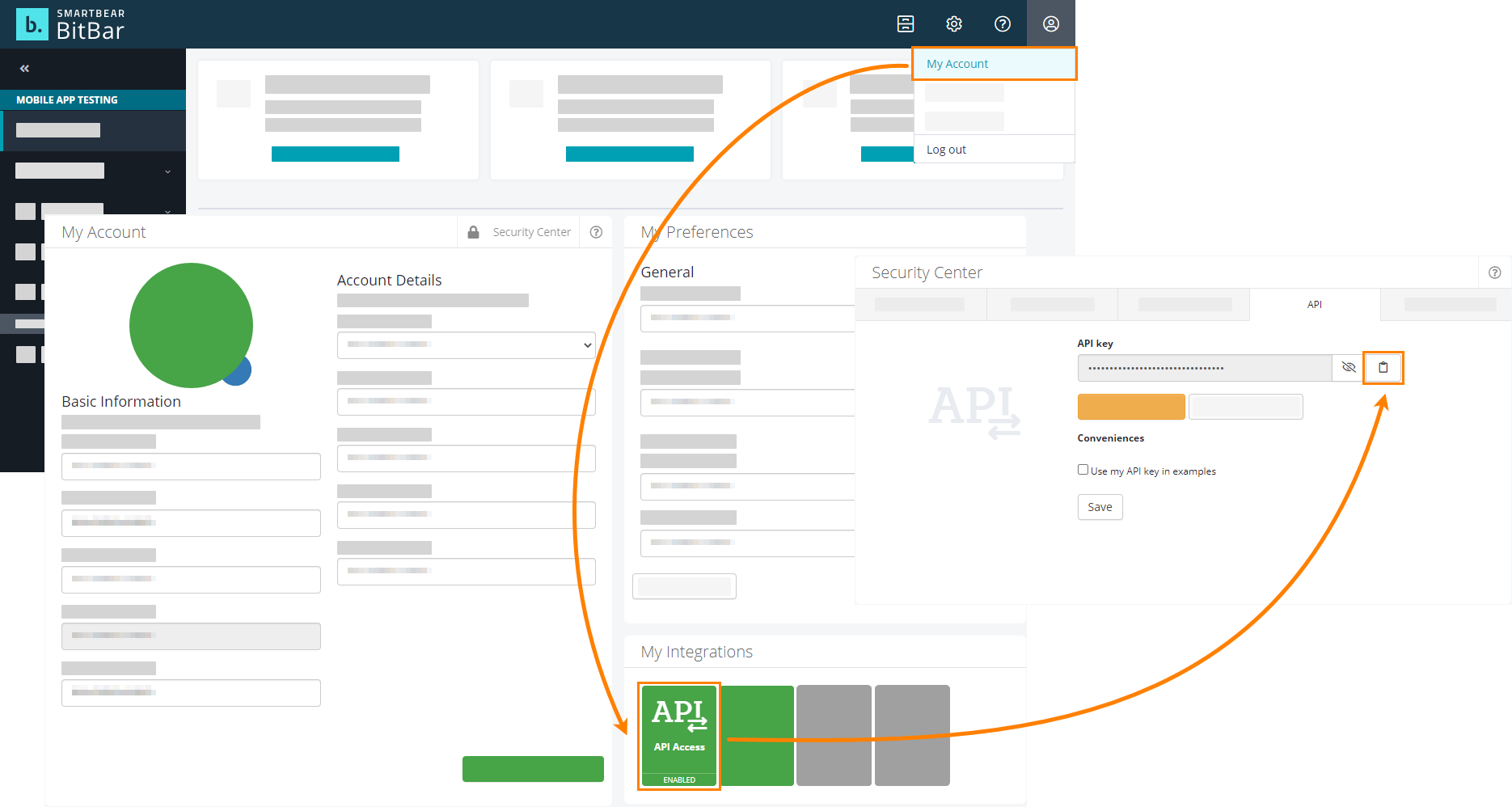Use the Select BitBar Device dialog to connect to a mobile device running in the BitBar device cloud or managed by a private Appium server and open a testing session on it.
|
The simple mode of the Select BitBar Device dialog |
The advanced mode of the Select BitBar Device dialog |
Requirements
This dialog is available only if the following requirements are met:
-
You have an active license for the TestComplete Mobile module.
-
The Appium Support plugin is enabled in TestComplete. You can check the plugin state in the File > Install Extensions dialog in TestComplete. You can find the plugin in the Mobile group.
-
Your current project is configured to use cloud-compatible mobile support (enabled by default).
To call the dialog
Click Show Mobile Screen on the TestComplete toolbar.
– or –
In the Mobile Screen window, click New Device in the device list.
To select the device
Depending on whether you use BitBar or a device managed by a private Appium server:
BitBar
-
If there is no BitBar API key specified in the current TestComplete project, enter the API key you will use to run tests and click Apply.
-
Select the mobile device and a tested application for which you want to open a testing session:
You can select devices that have any status in the Status column. However, the selected device must be Available when the test run starts.
-
If the selected device is not available, TestComplete will not be able to connect to it. To command TestComplete to search for a replacement device, select the Connect to another device when the selected one is not available check box. On the Device Cloud > Mobile page of your project, you can set the search criteria for the replacement devices.
-
In the Application drop-down list box, select a mobile application for which you want to open a testing session. The application file must be either stored in the BitBar Files Library or added to the Tested Applications of the current TestComplete project. In the latter case, click Upload to BitBar to upload the application file to the BitBar Files Library and then select it in the list.
For iOS only: To be able to launch and stop the tested application from tests or by using the Mobile Device Screen window of TestComplete, specify the bundle ID of the application when connecting to the device. It is the bundle ID that was used to compile the specified .ipa file. Add the
bundleIdcapability to the list of desired capabilities on the View more BitBar parameters > Custom Parameters tab.
-
To get more advanced options, click View more BitBar parameters:
-
On the Parameters tab, you can filter the device list by the device type, the version of the operating system running on the devices, their screen resolution, and their location.
-
By default, when a device is disconnected, the testing session on it is closed, and the device is restored to its initial state. Until the device is restored, it will remain unavailable. To keep the session alive to be able to reconnect to it, select the Keep the device available for quick reconnection check box. The session will be available for reconnection for up to 60 seconds.
-
If needed, on the Custom parameters tab, you can specify additional capabilities to be used for the testing session. Specify the capabilities in the JSON format. For example:
JSON
{
"bitbar_project": "Automated tests",
"bitbar_description": "Testing the Orders app"
}The JSON code will be validated as you are typing it.
Note: The capabilities you specify on the Custom capabilities tab can overwrite values specified on the Parameters tab.
For the list of available capabilities, see the BitBar Documentation - Desired Capabilities.
-
To open the testing session and connect to it, click OK. To close the dialog without connecting any device, click Cancel.
Local Appium
Note: You must have your local Appium server running and available from your TestComplete workstation. For information on how to configure a local Appium server, see Set up Appium Server.
-
Click Local Appium.
-
In the Server URL text box, enter the URL address of your Appium server. For Appium 2.x, the format of the URL should be http://localhost:4723 and for Appium 1.x the format should be http://localhost:4723/wd/hub.
-
In the Application Path text editor, specify the full path to the application that you want to install on the target mobile device and from which you want to open a testing session. If your application is added to the list of tested applications in your TestComplete project, you can click the down-arrow button and select the application path from the drop-down list. You can also type the path manually, or you can click the ellipsis button and browse for the needed application file.
Specify the application path relatively to the Appium server location.
You can also specify the application path using the
appcapability in the Parameters editor. Theappcapability value will override the Application Path value. -
In the Parameters editor, enter the capabilities that describe a testing session you want to open, in the JSON format. The dialog will validate the JSON code as you are typing.
For information on all available capabilities, see Appium Desired Capabilities.
To open the testing session and connect to it, click OK. To close the dialog without connecting any device, click Cancel.
See Also
Mobile Screen Window
About Mobile Tests
Connecting to Mobile Devices and Opening Testing Sessions



 BitBar
BitBar Learn how to get the API Key
Learn how to get the API Key
 to copy your API key to the clipboard.
to copy your API key to the clipboard.